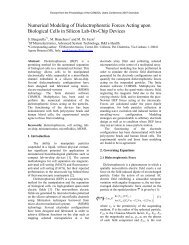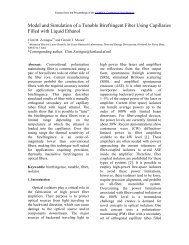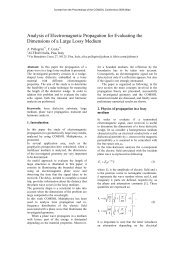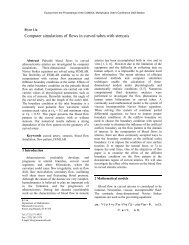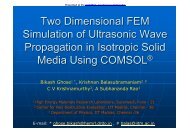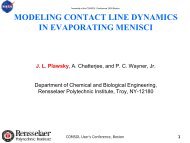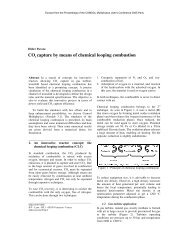Mathematical Modeling of Nanomaterials - COMSOL.com
Mathematical Modeling of Nanomaterials - COMSOL.com
Mathematical Modeling of Nanomaterials - COMSOL.com
You also want an ePaper? Increase the reach of your titles
YUMPU automatically turns print PDFs into web optimized ePapers that Google loves.
Excerpt from the Proceedings <strong>of</strong> the <strong>COMSOL</strong> Multiphysics User's Conference 2005 Frankfurt<br />
Figure 1. The intumescent nano<strong>com</strong>posite gel for the realization <strong>of</strong> retardant windows.<br />
1.1.2 Model description<br />
Our model represents the phase change from a virgin material (the gel) to a porous material<br />
(the final structure with bubble inclusions and after the carbonization <strong>of</strong> the organic<br />
<strong>com</strong>pounds) by a moving mushy front, mainly driven by outgassing. Here we do not consider<br />
a (hard) Heavyside phase front, usually used in problems <strong>of</strong> the Stefan type, which is more<br />
natural from a physical point <strong>of</strong> view. For this, a generalized form <strong>of</strong> the transient heat<br />
equation with a drain term representing the absorption <strong>of</strong> heat by endothermic reactions is<br />
employed.<br />
An additional mass conservation equation is coupled to this heat equation using a<br />
temperature dependent empirical function for the mass loss due to outgassing.<br />
This mass conservation equation is also used to derive the change <strong>of</strong> the porosity<br />
(normalized inverse <strong>of</strong> the density) <strong>of</strong> the material and the effective dynamic thermal<br />
conductivity (according to the Maxwell model).<br />
The dynamic porosity is related to the averaged bubble growth and growth limits are<br />
introduced by taking the stability <strong>of</strong> the bubbles into account. The stability <strong>of</strong> bubbles is<br />
strongly related to the insulating properties <strong>of</strong> the porous phase and the final glass matrix<br />
after the mushy transformation front has passed. The equations are solved in a domain Ω<br />
using the finite element method.<br />
To the derive the unknown empirical parameters as well as to validate the model, a number<br />
<strong>of</strong> experimental measurements were performed in a specially designed high temperature<br />
oven using (mechanically) stiff gel plates with a varying proportion <strong>of</strong> a hardening agent,<br />
which determines the growth and stability <strong>of</strong> bubbles, and different thicknesses <strong>of</strong> the plates.<br />
Genetic programming was applied to fit the model to the experimental data as well as the<br />
boundary conditions, in addition the general model conduction +convection + radiation was<br />
used to determine the free boundary.<br />
1.1.3 Results<br />
Our model provided a high correlation to the oven measurements using 1D and 2D numerical<br />
simulations. In particular, our model allowed for a representation <strong>of</strong> the temperature<br />
gradients in space over time and exhibited a good qualitative correlation in the phase change<br />
behavior, which was analyzed in a different set <strong>of</strong> experiments such as thermo-gravimetric<br />
analysis. The influence <strong>of</strong> the hardening agent was also reflected in the numerical<br />
simulations. In Fig. 2 (left) the outgassing function depending on the temperature is shown<br />
for particular sets <strong>of</strong> parameters. The temperature pr<strong>of</strong>ile at the backside (none heating side)<br />
<strong>of</strong> a stiff gel plate with a thickness <strong>of</strong> 20mm for different outgassing settings which are related<br />
to the proportion <strong>of</strong> hardening agent in the plates is shown Fig. 2 (right). The plateaus in<br />
curve reflect the active insulation properties due to outgassing <strong>of</strong> the aqueous nano<strong>com</strong>posite.


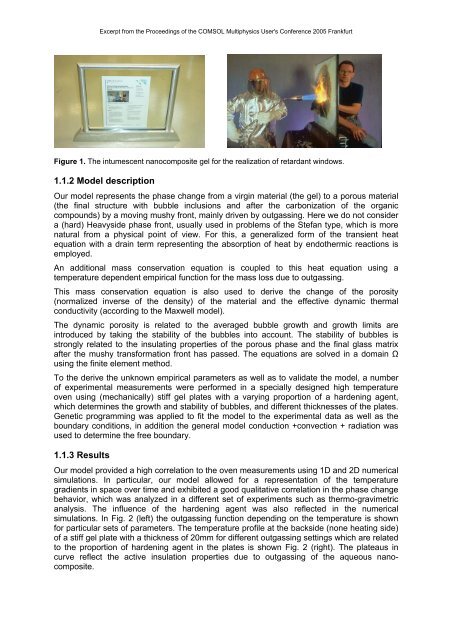
![[PDF] Microsoft Word - paper.docx - COMSOL.com](https://img.yumpu.com/50367802/1/184x260/pdf-microsoft-word-paperdocx-comsolcom.jpg?quality=85)
